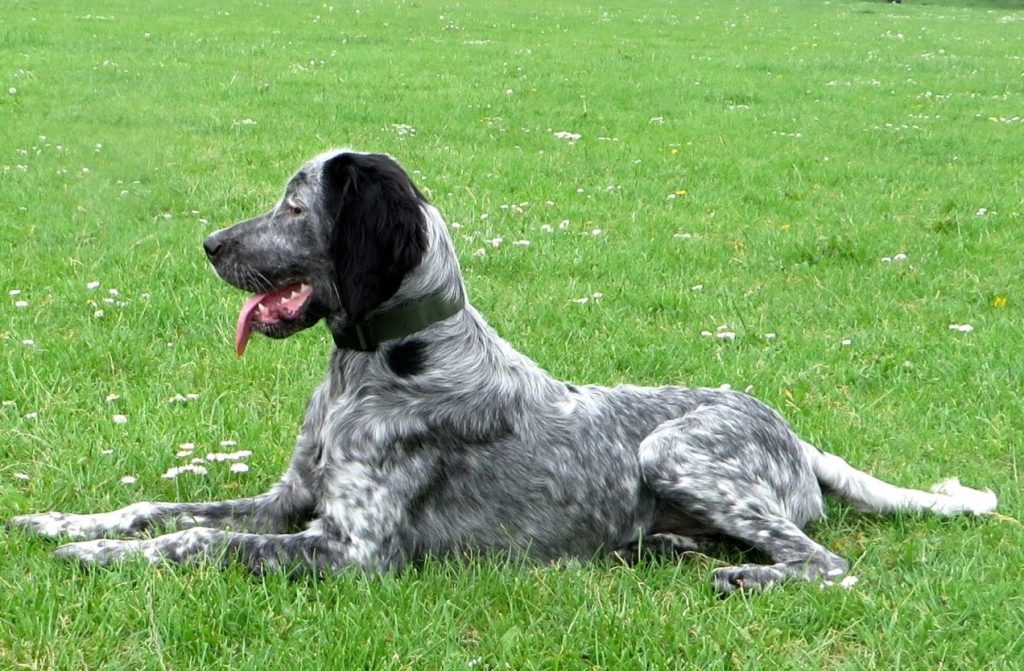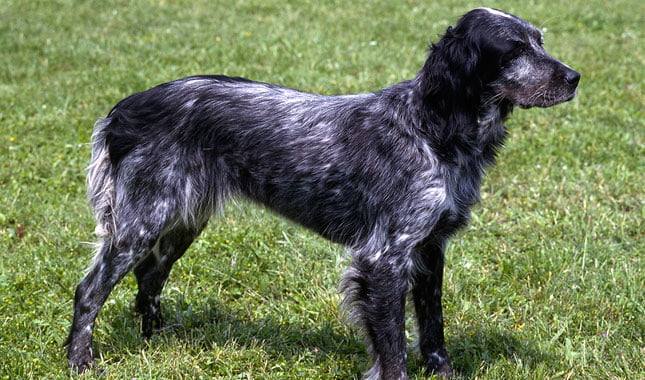Are you in search of a loyal and loving companion that is also highly trainable and active? If so, the Blue Picardy Spaniel breed may be the perfect pet for you! This breed is known for its gentle nature, intelligence, and strong work ethic. Originally bred for hunting, the Blue Picardy Spaniel is a versatile breed that excels in various activities such as agility, obedience, and tracking. In this article, we will explore the unique characteristics of the Blue Picardy Spaniel and why they make a great addition to any family.
Breed Category: Gundog
Country of Origin: France
Average Size:55-62 cm
Average Weight:20-25 kg
Average Life Span: 10-14 years
Grooming Requirements: Moderate
Exercise Requirements:High
History and Origin
The Blue Picardy Spaniel is a breed of dog that originated in the Picardy region of France. The breed is believed to have been developed by crossing local French spaniels with English Setters and Gordon Setters. The Blue Picardy Spaniel was primarily used as a hunting dog, particularly for hunting game birds such as pheasants and partridges. The breed is known for its excellent hunting skills, as well as its loyalty and affectionate nature.
The Blue Picardy Spaniel is a relatively rare breed, with only a few hundred dogs registered each year. The breed was recognized by the United Kennel Club in 1991, but is not yet recognized by the American Kennel Club. Despite its rarity, the Blue Picardy Spaniel is highly valued by hunters and dog enthusiasts for its excellent hunting abilities and friendly temperament.
The Blue Picardy Spaniel is a medium-sized dog, typically weighing between 45 and 60 pounds. The breed has a distinctive blue-grey coat, with black patches and speckles. The coat is thick and water-resistant, making it well-suited for hunting in wet conditions. The breed has a long, broad head and long, floppy ears. The Blue Picardy Spaniel is known for its gentle expression and friendly demeanor.
The Blue Picardy Spaniel is a highly trainable breed, and is known for its intelligence and eagerness to please. The breed is well-suited for a variety of activities, including hunting, obedience training, and agility competitions. The Blue Picardy Spaniel is also a great family pet, and is known for its affectionate and loyal nature. The breed is good with children and other pets, and is generally easy to train and socialize.
The Blue Picardy Spaniel is a relatively healthy breed, with few major health concerns. However, like all breeds, the Blue Picardy Spaniel is prone to certain health issues, such as hip dysplasia and ear infections. It is important for owners to provide regular veterinary care and to keep their dog’s ears clean and dry to prevent infections.
In conclusion, the Blue Picardy Spaniel is a unique and highly valued breed of dog that has a rich history and a bright future. The breed’s excellent hunting abilities, friendly temperament, and trainability make it a great choice for hunters, dog enthusiasts, and families alike.

Size and Breed Category
The Blue Picardy Spaniel is a medium-sized breed of dog that originated in France. They are known for their distinctive blue-grey coat, which is thick and water-resistant. The breed is classified as a gundog, which means they were originally bred for hunting and retrieving game birds.
In terms of size, the Blue Picardy Spaniel typically stands between 55-62cm tall at the shoulder and weighs between 20-25kg. They have a muscular build and a broad head with long, floppy ears. Despite their hunting background, they are also known for their gentle and affectionate nature, making them a popular choice as a family pet. However, they do require plenty of exercise and mental stimulation to keep them happy and healthy.
Fur Length and Colour
The fur of the Blue Picardy Spaniel is typically medium in length, with a dense undercoat and a slightly wavy topcoat. The fur is soft to the touch and provides excellent insulation, making it well-suited for cold and wet weather conditions. The fur is typically a mix of black, grey, and white, with the black and grey forming a mottled pattern on the dog’s back and sides. The white fur is usually found on the dog’s chest, belly, and legs, and may also appear as small patches on the face and ears. The overall effect is a striking and distinctive coat that is both functional and aesthetically pleasing.
The Blue Picardy Spaniel’s coat colour is an important characteristic of the breed, as it helps to distinguish it from other spaniel breeds. The black and grey mottled pattern is particularly striking, and is often compared to the colouring of a blue roan horse. The white fur provides a pleasing contrast to the darker colours, and helps to highlight the dog’s expressive face and bright, intelligent eyes. The coat is also relatively low-maintenance, requiring only occasional brushing and grooming to keep it looking healthy and shiny. Overall, the Blue Picardy Spaniel’s fur is a key part of its unique and appealing appearance.
Termperament and Trainability
Blue Picardy Spaniels are known for their calm and gentle temperament. They are affectionate and loyal to their owners, making them great family pets. However, they can be reserved with strangers and may require proper socialization to prevent shyness or aggression. These dogs are also highly adaptable and can thrive in both urban and rural environments. They have a moderate energy level and require regular exercise to keep them mentally and physically stimulated. Blue Picardy Spaniels are intelligent and eager to please, making them easy to train. They respond well to positive reinforcement techniques and enjoy learning new tricks and commands. With proper training, they can excel in various activities such as hunting, agility, and obedience competitions.
Blue Picardy Spaniels are a versatile breed with a high trainability level. They have a strong desire to work and are known for their excellent hunting skills. They have a keen sense of smell and can track game in various terrains. These dogs are also great swimmers and can retrieve game from water. Blue Picardy Spaniels are highly trainable and can learn complex tasks quickly. They have a strong work ethic and are eager to please their owners. However, they can be sensitive to harsh training methods and may shut down if treated unfairly. Positive reinforcement techniques such as clicker training and reward-based training are recommended for this breed. With proper training and socialization, Blue Picardy Spaniels can make excellent working dogs and loyal companions.

Known Health Conditions
Blue Picardy Spaniels are a breed of dog that are known to be prone to certain health conditions. One of the most common health issues that affect this breed is hip dysplasia. This is a condition where the hip joint does not develop properly, leading to pain and discomfort for the dog. It can also cause arthritis and mobility issues later in life. To prevent hip dysplasia, it is important to ensure that Blue Picardy Spaniels are not over-exercised as puppies and that they maintain a healthy weight throughout their lives. Regular check-ups with a veterinarian can also help to catch any signs of hip dysplasia early on.
Another health condition that Blue Picardy Spaniels are prone to is ear infections. This is because they have long, floppy ears that can trap moisture and bacteria, leading to inflammation and infection. To prevent ear infections, it is important to clean the ears regularly and to keep them dry. It is also important to avoid over-cleaning the ears, as this can cause irritation and make the problem worse. If an ear infection does occur, it is important to seek veterinary treatment as soon as possible to prevent it from spreading and causing further health issues.

Openness to Strangers
Blue Picardy Spaniels are known for their friendly and welcoming nature towards strangers. They are a breed that is always eager to meet new people and make new friends. This trait makes them excellent companions for families with children or those who frequently have guests over. Their open and sociable personality also makes them great therapy dogs, as they are able to provide comfort and support to those in need. Additionally, their intelligence and trainability make them easy to socialize and teach good manners, ensuring that they are always well-behaved around strangers.
When it comes to meeting new dogs, Blue Picardy Spaniels are generally quite accepting and friendly. They are not known to be aggressive towards other dogs and are often quite playful and affectionate with them. However, as with any breed, early socialization is important to ensure that they learn how to interact appropriately with other dogs. Blue Picardy Spaniels are also known to be good with other pets, such as cats, as long as they are introduced to them at a young age and taught to respect their boundaries. Overall, their openness to strangers extends beyond just humans and makes them a great addition to any household with multiple pets.
Playfulness Level
The Blue Picardy Spaniel is a highly playful breed of dog that loves to engage in various activities. They are known for their energetic and lively nature, which makes them an excellent companion for families with children. These dogs are always up for a game of fetch or a run in the park, and they thrive on physical activity. Their playful nature also makes them great at learning new tricks and commands, as they are always eager to please their owners.
In addition to their love for physical activity, the Blue Picardy Spaniel is also known for their playful personality. They are friendly and outgoing dogs that enjoy socializing with both humans and other animals. Their playful nature makes them a great addition to any household, as they are always ready to play and have fun. However, it is important to note that their high energy levels require regular exercise and mental stimulation to prevent boredom and destructive behavior. Overall, the Blue Picardy Spaniel is a fun-loving and playful breed that is sure to bring joy and entertainment to any household.
Suitability as a Pet for Children
Blue Picardy Spaniels are a friendly and affectionate breed, making them a great choice for families with children. They are known for their gentle nature and love to be around people, making them a loyal companion for kids. With their high energy levels, they are always up for a game of fetch or a run around the park, making them a great choice for active families. They are also highly trainable, making them a good choice for families who want to teach their children about responsibility and obedience. Overall, the Blue Picardy Spaniel is a great choice for families looking for a loving and active pet.
Exercise Needs
Blue Picardy Spaniels are a highly active breed that require plenty of exercise to maintain their physical and mental wellbeing. As a medium-sized breed, they need at least an hour of exercise every day, which can be achieved through a combination of walks, runs, and playtime. These dogs are natural hunters and have a strong prey drive, so it’s important to keep them on a leash or in a secure area when exercising them off-leash. Blue Picardy Spaniels also enjoy participating in activities such as agility, flyball, and obedience training, which can provide them with mental stimulation and help to strengthen the bond between dog and owner.
In addition to regular exercise, Blue Picardy Spaniels also benefit from mental stimulation and socialization. These dogs are intelligent and curious, and they thrive on learning new things and exploring their environment. Owners can provide mental stimulation through activities such as puzzle toys, scent work, and training exercises. Socialization is also important for Blue Picardy Spaniels, as they can be reserved or shy around strangers if not properly socialized. Exposing them to a variety of people, animals, and environments from a young age can help to build their confidence and prevent behavioural issues later in life.

Suitability for a Multi-Pet Family
Blue Picardy Spaniels have a reputation for being friendly and sociable with other pets. They are known to get along well with cats and other dogs, as long as they are properly socialized from a young age. These dogs are not typically aggressive towards other animals and are often quite playful and affectionate. However, as with any breed, individual temperament can vary, so it is important to introduce Blue Picardy Spaniels to other pets slowly and carefully.
Housing Requirements
Blue Picardy Spaniels are a breed that require a moderate amount of exercise. They are known for their love of the outdoors and enjoy activities such as hiking, swimming, and retrieving. A daily walk or run is recommended to keep them physically and mentally stimulated. They also benefit from having access to a secure outdoor space where they can play and explore. As a hunting breed, they have a strong prey drive and should always be supervised when off-leash.
In terms of housing, Blue Picardy Spaniels can adapt to a variety of living situations as long as their exercise needs are met. They can live in apartments or smaller homes as long as they receive enough daily exercise. However, they thrive in homes with access to a yard or outdoor space where they can run and play. They are social dogs and enjoy being around their family, so they should not be left alone for long periods of time. They also have a thick, water-resistant coat that allows them to tolerate colder temperatures, but they should not be left outside in extreme weather conditions.
Summary
Blue Picardy Spaniels are a popular choice for pet owners in the UK due to their friendly and loyal nature. They are known for their intelligence and trainability, making them a great choice for families with children or those who enjoy outdoor activities. Additionally, their moderate energy levels make them suitable for both apartment living and larger homes with yards. Overall, the Blue Picardy Spaniel is a wonderful companion for those seeking a loving and active pet.
Blue Picardy Spaniel Dog FAQS
Yes, Blue Picardy Spaniels are intelligent and eager to please, making them relatively easy to train.
Yes, Blue Picardy Spaniels are known to be great with children and make excellent family pets.
Blue Picardy Spaniels can be prone to hip dysplasia and ear infections. Regular vet check-ups are recommended.
While Blue Picardy Spaniels can adapt to apartment living, they require plenty of exercise and outdoor time. A house with a yard is ideal.
Yes, Blue Picardy Spaniels are an active breed and require at least 1-2 hours of exercise per day.
Yes, Blue Picardy Spaniels have a thick double coat and shed moderately throughout the year.
Blue Picardy Spaniels should be brushed at least once a week and bathed every 2-3 months.
Blue Picardy Spaniels usually grow to be around 55-60 cm tall.
The average weight of a Blue Picardy Spaniel is between 20-25 kg.
The average lifespan of a Blue Picardy Spaniel is between 10-14 years.






Leave A Comment